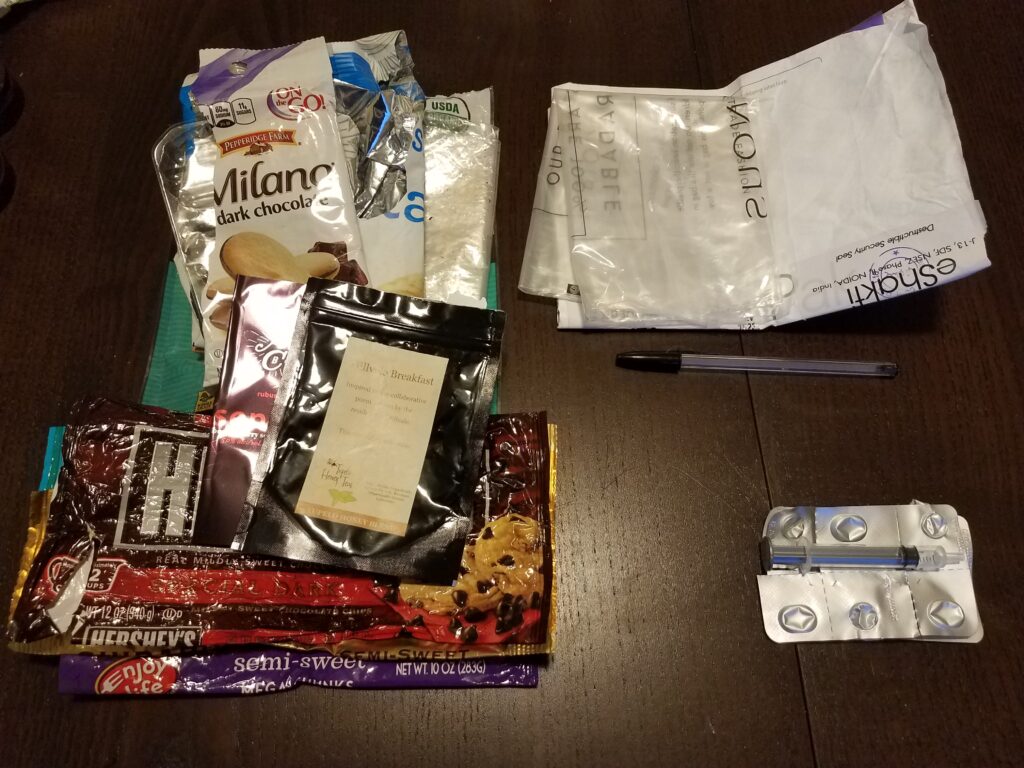Part 4 – The Plastic We Wear
When I did my Zero-Waste Lent challenge about a year and a half ago (one of the main reasons why I had so many friends suggesting that I start this blog in the first place), I took a really deep dive into clothing research. The thing that really sparked my interest was the fact that right at the beginning of this challenge – the first day of Lent, as a matter of fact – I ripped my last pair of stockings, and I wanted to figure out whether or not I could replace them.[1] Upon researching what materials actually go into making a pair of stockings, it struck me how common plastic is in our clothes.
Nylon is plastic; polyester is plastic; vegan leather is plastic. And while I wasn’t going to buy any plastic I couldn’t recycle during Zero-Waste Lent, and while I’m not going to buy any plastic at all during Plastic-Free July, it’s a purchase I try to limit in general throughout the year. It is ironic that I should say this, given that between my husband (a cyclist) and me (a runner), we have enough spandex and polyester in the house to open a sporting goods store.
The Case Against Synthetics
There are plenty of problems with the plastics in our clothing – from the drilling for oil which they are made, to the refining processes used to make them – but those are a topic for another post (or, more likely, series). For the purposes of this post, we will stick to the problem of what happens when we wash our plastic clothes.
Washing synthetic clothes makes the fabrics break down ever so slightly, and those tiny pieces of plastic are carried away in our wastewater. Added up, these “microplastics” amount to a huge quantity of plastic pollution. In fact, “microplastic pollution caused by washing processes of synthetic textiles was discovered to be one of the main sources of primary microplastics,” according to an article in Nature. “Results showed that microfibres released during washing range from 124 to 308mg for kg of washed fabric.”[2]

Unfortunately these microplastics bypass filters at wastewater treatment plants, and much of it ends up in waterways. “The most commonly accepted estimate for the amount of plastic that ends up in the ocean each year is 8 million metric tons. Of that, microplastics are thought to make up an estimated 1.5 million tons, and a 2017 report by the International Union for Conservation of Nature estimated that about 35 percent of microplastics that enter the world’s oceans comes from synthetic textiles.”[4]
The more vigorous your wash cycle is, the more your fabric will break down. According to one study, “microfiber masses from top-load machines were approximately 7 times those from front-load machines.”[5] (This makes me wonder how much of my own microplastic waste is getting back into the water supply, since my laundry greywater goes straight to my garden.[6])
The Wall Street Journal reported that “makers of sportswear and fleece jackets are trying to address concerns about tiny plastic particles from synthetic clothing finding their way into seafood and drinking water.”[7] Patagonia is one such company conducting studies about microplastics in clothing, and they are also examining ways to capture microfibers before they leave the washing machine, including something akin to a lint trap. Of course, the easiest way to keep microplastics out of your laundry water is to opt for natural fibers over synthetics.

On the left: absolutely roasting in synthetic gown and veil – and camping in a nylon tent (photo credit: Doug Weed)
On the right: reasonably comfortable in linen gown and veil – and camping in a canvas tent (photo credit: Christian Korey)
The Case for (and Against) Natural Fibers
It is interesting to remind ourselves that synthetic fabrics have only been around since the 1930s, when nylon became a mass-market alternative to silk.[8] In less than a century, we’ve literally gone from zero to 60 (percent) with synthetics. In a world where fashion changes so quickly, you don’t need clothing that’s going to last, and that’s where cheap, short-lived fabrics come to the rescue. There is another option, however – another set of options: natural fibers, which we’ve been using to make clothes ever since the fig leaf went out of fashion.
I find it amusing that whenever I attend a medieval reenactment in the heat of summer or the dead of winter, the attendees who seem to be the most comfortable are those who are wearing the most historically-accurate materials – wool, linen, and silk. We usually laugh and say “it’s almost as if these people knew what they were doing!” When I first started attending events over ten years ago, I made myself a beautiful gown from a synthetic silky fabric because I didn’t want to buy actual silk. And while I always get a lot of compliments on how pretty it is, I also roast in it every single summer. Natural fibers are easier on the environment as they break down and are (at least anecdotally) more comfortable in extreme weather.
Of course, I could say that we should all be buying natural fibers, but we also can’t ignore the concerns inherent in production. Leather and silk result in the deaths of the animals involved,[9],[10] to say nothing of the ethics of fur. Even the collection of down and wool raises questions about the humane treatment of the animals.[11],[12] Cotton is plant-based but water-intensive in its production and typically involves large quantities of arable land and pesticides (organic cotton requires more land because of lower output per plant).[13] Rayon is made from plant sources (viscose from bamboo), but it also requires large amounts of water and harmful chemicals to produce.[14]

On the left: Petra and Matthew in summer, wearing linen, wool, and leather (photo credit: Rachel Case)
On the right: Aneleda in the winter, wearing wool and fur (photo credit: Drew Bouchard)
Buying Less as a Solution
So what do we do when there seem to be downsides across the board (perhaps with the exception of linen[15])? Synthetics create microplastic waste that winds up in our waterways and food, but ethically-sourced natural fibers are expensive and can be hard on animals involved. One option is simply to buy less – which in some cases is happening automatically right now, and not by choice. As more people go without paychecks in the pandemic and worry about putting food on the table and making rent payments, they’re less likely to be shopping for clothes. In fact, I’ve seen many online clothing stores advertising going out of business sales in my Facebook feed. People just aren’t in the position to be shopping now.
In fact, I’ve been stalled out on shopping since Zero-Waste Lent last year. It helps that I don’t like clothes shopping to begin with, but I think I’ve only purchased one or two garments in the past year and a half. I don’t believe I’ve purchased a single pair of shoes since then because I’m honestly torn on the leather vs. plastic issue. I’ve owned a few pairs of vegan leather boots over the years, and they just don’t hold up as well as my leather boots. When I finally have to break down and make a decision, I will probably go with leather, but I’m not thrilled about the decision. I would love to do a full life cycle analysis on each to look at water use, related emissions, and how quickly they break down, but I haven’t made the time to do that yet… and I have trouble figuring out how to weigh the life of an animal in that equation.
While the best option is limiting your intake and reducing the overall demand for more fabrics, that’s hardly the American way. Consumption is ingrained in our society at a very deep level. Therefore, next week we’ll look at some options that are better than others if you must shop.

Plastic from the rest of the house: packaging from two dresses I ordered in June, shipping bag from reusable mask purchase (also June), and an inkless pen
New plastic purchased so far: pill packaging and a plastic syringe for kitty medication, plus plastic shrink wrap from a new notebook for work
Month to Date
This week was largely a success in that only two plastic bags (one from an online purchase in June and one from a stack of veggie burgers in my freezer) were added to the pile. Most notably, I made it through the week using only reusable menstrual products, which would have been significantly more difficult if I weren’t currently working 80% from home. (I had a whole post on zero-waste periods last year if you’re interested in getting more details.[16])
~
Have you spent any time comparing synthetic versus natural fibers in your own wardrobe? I’d love to hear about your experiences.
Thanks for reading!
[1] https://radicalmoderate.online/zero-waste-lent-week-5-clothing/
[2] https://www.nature.com/articles/s41598-019-43023-x
[3] https://www.vox.com/the-goods/2018/9/19/17800654/clothes-plastic-pollution-polyester-washing-machine
[4] https://www.nbcnews.com/mach/science/fight-against-plastic-pollution-targets-hidden-source-our-clothes-ncna1000961
[5] https://pubs.acs.org/doi/abs/10.1021/acs.est.6b03045
[6] https://radicalmoderate.online/greywater-reuse-and-laundry-detergent/
[7] https://www.wsj.com/articles/the-tiny-plastics-in-your-clothes-are-becoming-a-big-problem-11551963601
[8] https://en.wikipedia.org/wiki/Synthetic_fiber
[9] https://www.commonobjective.co/article/fibre-briefing-leather
[10] http://www.silk-road.com/artl/egyptsilk.shtml
[11] https://www.theguardian.com/world/2016/jan/14/winter-coat-ethically-produced-down-goose-feathers
[12] https://www.theguardian.com/environment/2014/sep/14/is-it-ethical-to-buy-wool-ethical-dilemma
[13] https://www.theworldcounts.com/challenges/consumption/clothing/cotton-farming-water-consumption
[14] https://bthechange.com/how-viscose-rayon-fabric-masquerades-as-bamboo-clothing-b-the-change-media-89f0e3038179
[15] https://www.anatolico.co/blogs/news/how-eco-friendly-is-linen
[16] https://radicalmoderate.online/zero-waste-lent-week-2-periods/
0 Comments